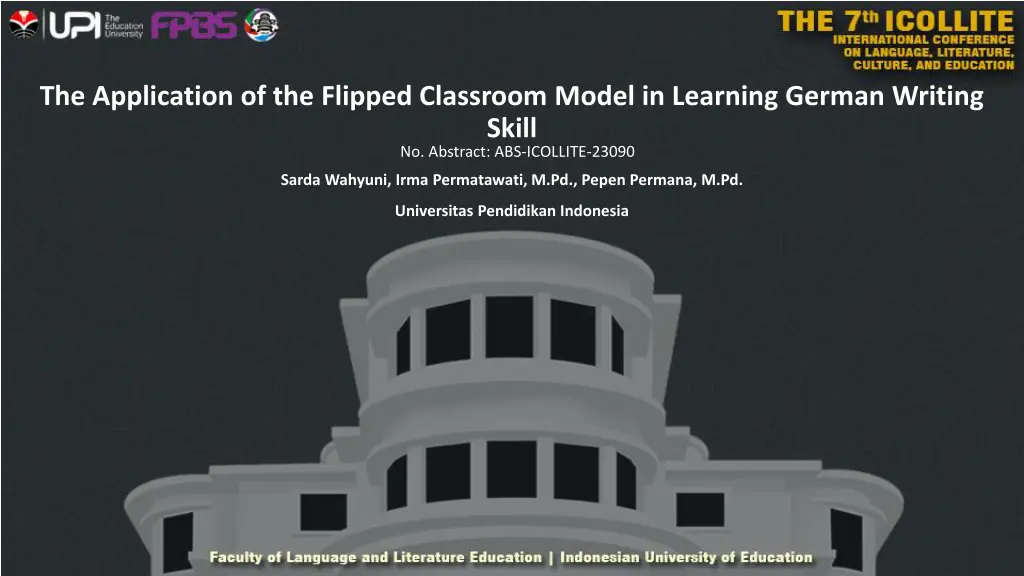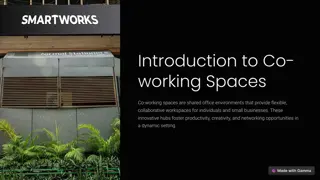
Application of Flipped Classroom Model for German Writing Skill Improvement
Explore how the Flipped Classroom Model is utilized to enhance German writing skills, addressing challenges faced by students in conventional classroom settings. This research delves into the effectiveness of the model through a quantitative study conducted with high school students in Indonesia, offering insights into student performance and learning outcomes.
Download Presentation

Please find below an Image/Link to download the presentation.
The content on the website is provided AS IS for your information and personal use only. It may not be sold, licensed, or shared on other websites without obtaining consent from the author. If you encounter any issues during the download, it is possible that the publisher has removed the file from their server.
You are allowed to download the files provided on this website for personal or commercial use, subject to the condition that they are used lawfully. All files are the property of their respective owners.
The content on the website is provided AS IS for your information and personal use only. It may not be sold, licensed, or shared on other websites without obtaining consent from the author.
E N D
Presentation Transcript
The Application of the Flipped Classroom Model in Learning German Writing Skill No. Abstract: ABS-ICOLLITE-23090 Sarda Wahyuni, Irma Permatawati, M.Pd., Pepen Permana, M.Pd. Universitas Pendidikan Indonesia
INTRODUCTION Writing is a productive language skill that plays a significant role in daily life. In German learning, writing remains one of the biggest challenges for students, assumed to be due to the lack of practice time for writing in the German language in the classroom. An appropriate learning model is needed to address this issue. One of the models assumed to be applicable as a solution is the Flipped Classroom Model. This model prepares students for self-directed learning activities before the face-to-face meetings in the classroom.
LITERATURE REVIEW "Flipped Classroom" comes from the word 'flip' which can be interpreted as 'inverted'. The meaning of inverted refers to the reverse learning cycle of the conventional learning model. Flipped Classroom is a new learning model used in schools in Indonesia. Flipped Classroom itself began to gain popularity in 2012 by Jonathan Bergmann and Aaron Sams through their book titled "Flip your Classroom." The understanding of Flipped Classroom is explained by Bergmann and Sams (2012, p. 15) as follows: Flipped Classroom is pedagogical model that reverses the traditional teaching method. Traditionally, students study the lecture together in the classroom and do assignments outside of classroom. With Flipped Classroom, students learn with instructional videos or other resources outside of classroom at their own pace and do assignments and interactive activities in the classroom.
METHOD This research is a quantitative study using a quasi-experimental method. The population in this study consists of students from Grade X of SMA Negeri 4 Cimahi in the academic year 2022/2023, while the sample includes 20 students from Class X IPA 1 as the experimental group and 20 students from Class X IPA 4 as the control group. This research was conducted based on permission from the respective school. The research instruments used were as follows: (1) Lesson Implementation Plan (Rencana Pelaksanaan Pembelajaran - RPP); (2) Evaluation instruments or written tests; (3) Research questionnaires; (4) Student Activity Sheets (Lembar Kegiatan Peserta Didik - LKPD). The data analysis conducted includes tests for normality, homogeneity, paired sample t-test, and independent sample t-test.
FINDING AND DISCUSSION The results of the research show that: 1) Students German writing skills before the implementation of the Flipped Classroom model in the experiment class and the control class are in the poor category; 2) Students German writing skills after the implementation of the Flipped Classroom model in the experiment class are in the good category, while in the control class still in the poor category; 3) There is a significant difference in students ability in German writing skills in the experiment class before and after the implementation of Flipped Classroom model; 4) The implementation of Flipped Classroom model is effective in learning German writing skills, as evidenced by the results of the independent t-test calculation with a significance level (2-tailed) of less than 0.05 (0.000 < 0.05); 5) Students demonstrate a positive response to the implementation of the Flipped Classroom model in learning German writing skills.
CONCLUSION 1) Students German writing skills before the implementation of the Flipped Classroom model in the experiment class and the control class are in the poor category; 2) Students German writing skills after the implementation of the Flipped Classroom model in the experiment class are in the good category, while in the control class still in the poor category; 3) There is a significant difference in students ability in German writing skills in the experiment class before and after the implementation of Flipped Classroom model; 4) The implementation of Flipped Classroom model is effective in learning German writing skills, as evidenced by the results of the independent t-test calculation with a significance level (2-tailed) of less than 0.05 (0.000 < 0.05); and 5) Students demonstrate a positive response to the implementation of the Flipped Classroom model in learning German writing skills. Based on the research results, the Flipped Classroom model can be considered as one of the alternative learning models in teaching German writing skills. Based on the research results, the Flipped Classroom model can be considered as one of the alternative learning models in teaching German writing skills.
REFERENCES Bergmann, J., & Sams, A. (2012). Flip your Classroom: Reach Every Student in Every Class Every Day.
THANK YOU! Follow us @...






















